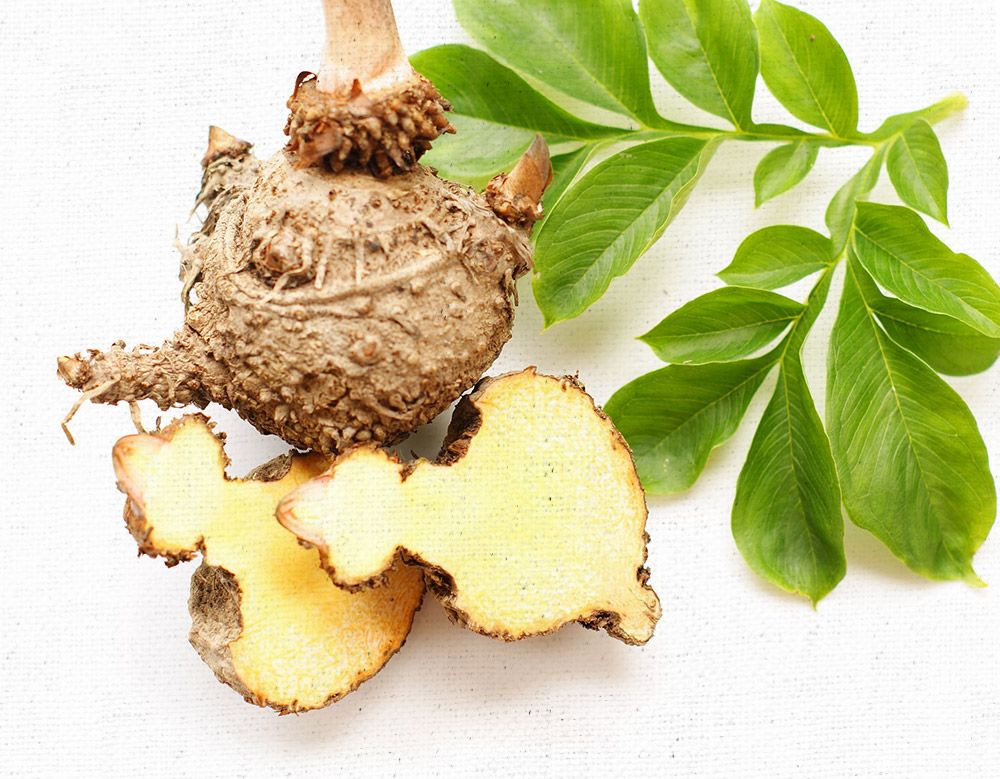Konjac (aka Amorphophallus konjac, konjaku, konnyaku potato, devil’s tongue, voodoo lily, snake palm, or elephant yam) is a plant typically cultivated in Asia since the 6th century with an edible corm/tuber considered a medicinal food.
Load More
Konjac powder is the dried, ground corm (underground plant stem) of the konjac plant. It is about 40% glucomannan – a water soluble dietary fiber with many health benefits.
Load More
Konjac powder is a more concentrated source of fiber and is extremely low in calories and carbohydrates. Compare 100gm of oats which is 389 calories, or 100gm of flax meal which provides 534 calories, to 100gm of konjac powder which has just 0.6 calories.
Load More
Pretty much anyone can consume konjac, except if you have to be on a low fiber diet. It is safe for children, and is vegan, grainfree, glutenfree, low carbohydrate and low calorie. It is unsafe for anyone to consume dry konjac powder because it can cause chocking due to the fact that it gels very quickly when it comes into contact with liquid.
Load More
Konjac powder itself is tasteless and odourless. I add it to recipes and foods I prepare for my children all the time and they cannot detect it…and they are very picky!
Shirataki noodles do have a rather odd smell but rinsing them under water removes it completely and they then have no flavor or smell. The whole point of adding konjac powder to your shirataki noodle recipes is it makes your sauce stick to the noodles and give them flavor.
Load More
The leaf of the konjac plant (Voodoo lily) is very frost sensitive and must be grown indoors as a house plant or as a seasonal outdoor plant. The buried tubers, however, are supposedly hardy to zone 6.
Load More
You absolutely can, but you may not want to grow a konjac plant inside your home. The konjac plant produces gorgeous dark purple flowers. But when in bloom, it produces an odor like a dead animal, in order to attract the carrion flies that are its natural pollinators.
Load More
Like any fiber, konjac glucomannan can cause diarrhea or constipation in excess. It is recommended that you start with a teaspoon per day and slowly increase to determine your individual tolerance. I personally consume probably at least 6 tsp a day, and often more. I suffered from Irritable Bowel Syndrome since my youth but now have no issues with my digestion. In contrast, I found that chia and flax seeds cause me extreme abdominal pain, bloating and gas and have had to eliminate them entirely from my diet.
Load More
Konjac should be stored in a cool, dry place, away from any heat sources, and sealed in the original packaging. It will be ruined if it comes into contact with any moisture.
Load More
Shirataki noodles and rice contain konjac. Some just contain konjac while others add soy, oat fiber or other ingredients. A number of appetite suppressant/weight loss supplements contain glucomannan from the konjac plant, and there are beauty sponges made from konjac as well.
For years, the food industry has been using konjac as a fat replacement in various meat products and to make vegan meat substitutes.
Load More
Good question! Konjac is unlike any other food product or plant. People generally take a while to get used to new things. Apparently, it took us a long time to get comfortable with quinoa. It is also not obvious to people right away how to use it. That’s where I come in!
Load More
In Asia konjac is pronounced like ‘cognac’, but I don’t say it that way here in North America because people misinterpret what I am referring to. I pronounce the J.
Load More
Numerous times a week you will find me enjoying konjac noodles stir fried with veggies and some sort of protein in a spicy peanut or sesame sauce. I toss in a tsp of konjac powder right before serving. Bar none, this is one of my favorite meals of all time.
I can also be found whipping up mocha frappes (even in winter) with water, ice, espresso powder, cocoa, stevia and konjac powder. Creamy and delicious!
I regularly simmer various types of fruit with water and then add enough konjac powder to get the desired consistency to create everything from compotes, jam, pie filling, pancake topper,etc. To satisfy my sweet tooth I am always experimenting with different baking recipes to create healthy cakes and cookies.
Load More
Yes! My husband takes several capsules full every day, plus has it in whatever I’ve cooked up for us. He struggled with high cholesterol (which runs in his family) no matter what he did, but for the past few years of taking konjac daily, it has remained at a healthy level. My kids eat lots of things I make with it too.
Load More
My kids tend to enjoy a lot of the baked goods, smoothies, puddings and frozen treats I make with konjac (especially anything with chocolate!). Since they were toddlers, I have been making them a turkey taco filling made with ground turkey, a pound of pureed cauliflower and pureed tomatoes, that is thickened with konjac powder, and they adore it.
My youngest daughter loves my fruit compotes while my oldest daughter’s favorite recipe is my black bean brownies.

